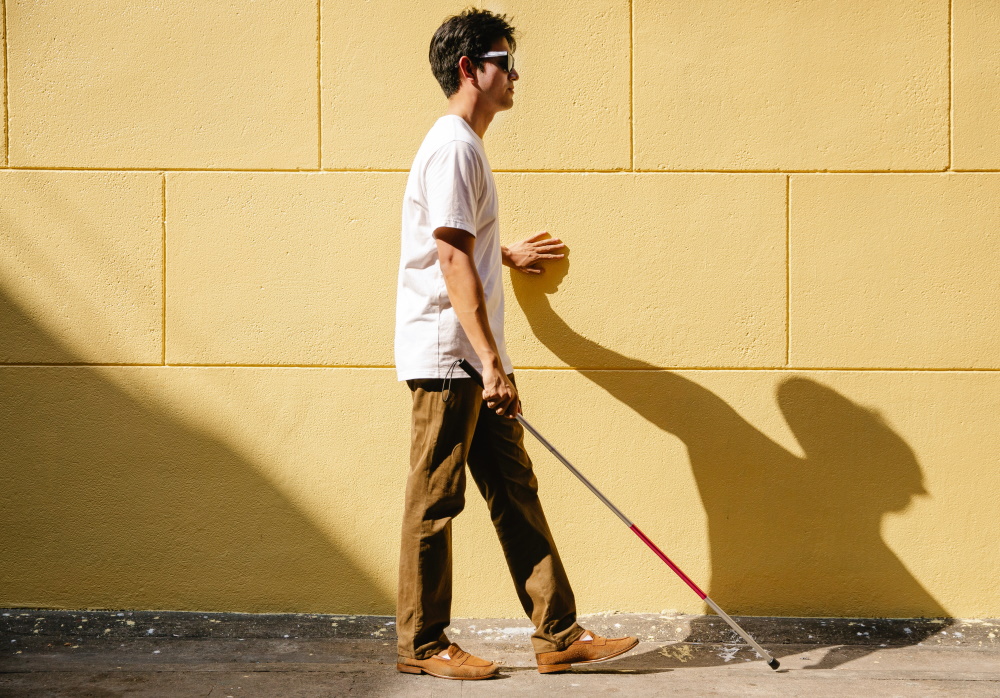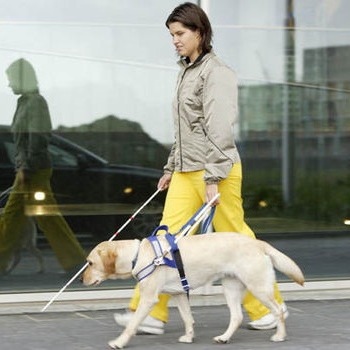Our mission is to develop an innovative, wearable system that gives blind users more freedom to participate in all aspects of society. Ximira is a social purpose corporation, driven by passionate volunteers who wish to create the best solution at the least cost to the user.
The Challenge

The world is designed by the sighted, for the sighted. Blind individuals face significant barriers in:
- Mobility
- Education
- Employment
- Healthcare
- Safety
- Day-to-Day Activities
These barriers severely limit the ability for the blind to participate in society. This can cause significant psychological and emotional stress for the blind individual and their caregivers. Moreover, it has a significant economic impact on society as the majority of working-age blind people are under- or unemployed; rather than contributing to their fullest potential, often they must rely on the help of others, placing yet further drag on economic and societal wellbeing.
As our population grows and ages, the number of people living With blindness is expected to increase disproportionately. The Centers for Disease Control in the United States estimates that, by 2050, there will be more than 6 million blind individuals in the US alone.
Existing Options

Traditional
The most common navigation aids for the blind are the white cane and guide dog. These remain vital, but come with significant limitations. Both clearly identify the user as blind, with potentially undesirable consequences.
White Cane
- Total Cost: $10-$100
- Proven and simple
- Inexpensive and ubiquitous
- Limited to obstacle avoidance
- No routing/navigation ability
- Only ground-level impediments
- Impractical in crowded spaces
Guide Dog
- Total Cost: $45,000-$60,000
- More navigation utility
- Psychological benefits
- Usually no-upfront cost for user
- High-cost/Low-volume training
- Long-term cost & commitment
- Not welcome in all situations

Technological
There are numerous current and planned technological options to help the blind with mobility, navigation and other day-to-day tasks. All have shortcomings that we hope to address with our solution. For example:
- "smart cane" concepts lack camera-based vision for scene and object detection and leave only one hand free
- smartphone-based solutions don't provide mobility assistance (still need cane/dog), take time to launch, and generally are not hands-free
- current head-worn solutions are prohibitively expensive and provide very Limited capabilities (e.g., on-demand reading and scene description)
Ximira's Solution: PHINIX
Ximira's PHINIX (Perceptive Helper with Intelligent Navigation and Intuitive eXperience) is a wearable system that allows people who are blind to walk safely and freely. PHINIX is designed around several required system characteristics. It must be:
- Handsfree – the system must leave users with the ability to use their hands freely
- Mobile – the system must be capable of operating many hours on battery power
- Unimpairing – the system must not adversely interfere with the user's senses, especially hearing, touch and remaining vision
- Natural & Intuitive – the system should be easy to learn and use, even for those with little technical knowledge; utility must not be hampered by poor usability
- Adaptable – the system must meet the needs of users with varied impairments and abilities
- Real-time / Always-on – for many core features, especially indoor and outdoor navigation assistance, the system must remain active and provide real-time feedback
- Extensible – the system must easily accommodate new/upgraded features and peripherals
- Modular – the system should be composed of independent and isolated components to minimize interdependencies and maximize flexibility
- Agnostic – the system should minimize migration costs for supporting new/alternate hardware
- Multimodal – the system should allow user interaction using a variety of mechanism, including auditory/verbal, haptic/gestural and graphical/touch
- Unobtrusive – the system should not draw undue attention to the user’s visual impairment
- Compact – the system should be small and lightweight enough to wear comfortably all day
- Wireless – the system should not require wires to communicate with peripheral devices
- Cloud-Optional – the system should support cloud-enabled features, but should not depend on an Internet connection for core functionality
- Open – the system should enable an ecosystem of open collaboration and contributions both directly to core design and functionality as well as through turnkey peripheral devices
Initial Core Functionality
We expect initial releases of PHINIX to provide the following core functionality:
- Mobility Assistance
- Obstacle Detection / Avoidance
- Stair / Curb Detection
- Outdoor Mobility Assistance
- Crosswalk and Sidewalk Following
- Traffic / Pedestrian Signage
- GPS-Based Point-of-Interest (POI) Localization
- Outdoor Scene Description
- Object Identification
- Face Identification
- OCR / Text-to-Speech
Features offered in the initial release will still require significant refinement. As such, early versions of PHINIX will not be capable of fully replacing existing navigation aids.
Core Components
As noted, PHINIX is extensible and modular, so it is expected that the system will evolve significantly over time. However, the system is designed around five core hardware components:
- Compute Module with Battery
- Vision Module with 3D Camera
- Wireless Haptic Wristbands
- Wireless Open Ear Headset
- Mobile Phone/Tablet Application
Initial versions of PHINIX will house the compute module in a compact, cross-body pack. The vision module will be attached to the strap of the pack and physically connected via a USB cable.
User Interface
PHINIX offers three complementary user interface modalities. To avoid information overload, the user can configure the nature, quantity and volume of the information provided by each.
- Auditory / Voice (Headset) – PHINIX leverages text-to-speech capabilities to communicate information to the user, as well as advanced speech recognition to receive instructions from the user.
- Haptic / Gestural (Wristbands) – PHINIX sends haptic messages to the user by emitting custom vibratory waveforms through four haptic motors embedded in the wrist bands. The user can also give commands to the system using gestures.
- Graphical User Interface (GUI) / Touch – PHINIX supports interaction via mobile phone or tablet applications, which already support rich assistive adaptations for the visually impaired.
For additional details regarding specific hardware and software design considerations, please read more about our technology.